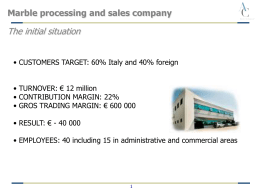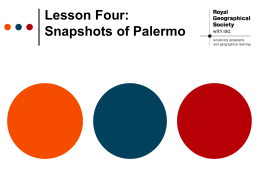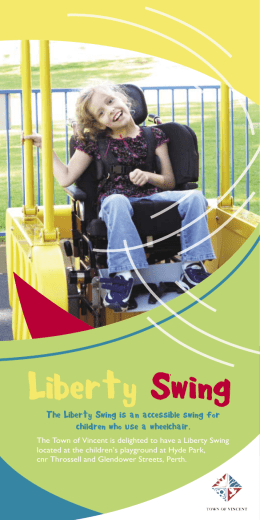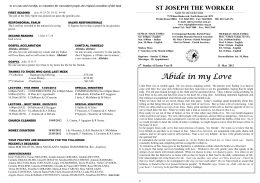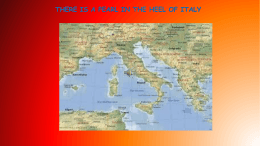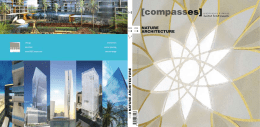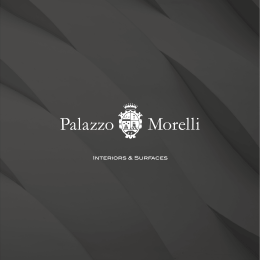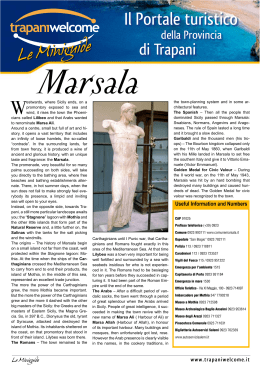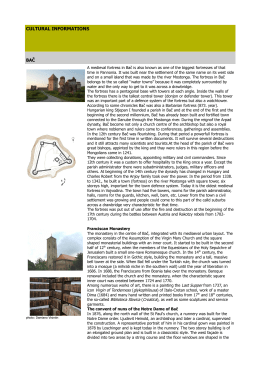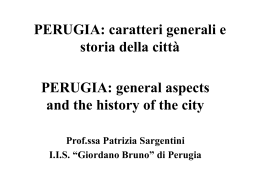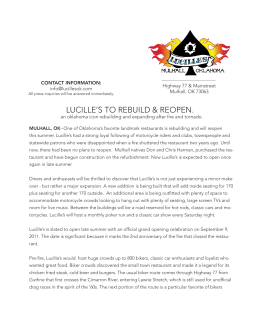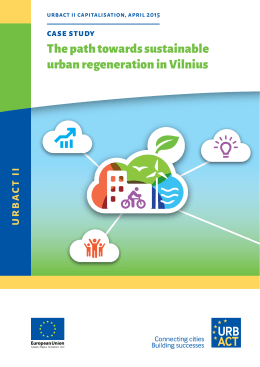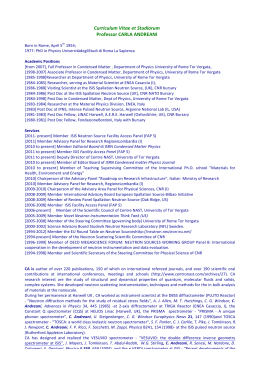DISCOVERING POLISTENA Progetto PON “Comunichiamo in Inglese” HISTORICAL NOTES The origins of Polistena are uncertain. Located on a ridge between the Vacale, Jerulli and Jerapotamo torrents, it was a crossing point for the people of Locri along the road towards their colony, Medma. Polistena probably existed in the Byzantine period, but there is also important evidence of the Roman era. In 1669 the town obtained the title of Marquisate and City, consolidating the ancient role of urban centre, silk and art market. The town was destroyed by an earthquake in 1783. A TOWN OF CULTURE AND ART Polistena was a town of culture and art. In Polistena there was a school of sculpture, stucco decoration and painting. Morani and Jerace were the most important sculptors. Polistena has an important musical tradition. Antonello Marafioti was the most important musician in the 16th century. CHURCHES AND WORKS OF ART Chiesa Madre, with its imposing three-nave form, contains a marble column of the Deposition of Jesus Christ, a sixteenth century work of priceless value. There is also a marble altar of SS. Sacramento with the painting of “The Last Supper” by F. Jerace. The “Resurrection of Lazarus” is a magnificent canvas prominent in the vault, realised by C. Zimatore at the beginning of the twentieth century. Very interesting is the wooden choir stall, the work of G. Silipo (1893). CHURCHES AND WORKS OF ART Chiesetta dell’Annuziata was rebuilt after the 1783 earthquake. It is a small church containing a wooden statue of the Blessed Virgin. Chiesa di S. Maria degli Angeli is located within Palazzo Riario Sforza. The church has an altar made from multicoloured marble; a marble relief of S.Maria di Loreto; inscribed headstones; a holy water stoup and a marble sarchophagus by G.D. Milano. CHURCHES AND WORKS OF ART Chiesa di S. Francesco has a façade with an imposing lithic portal and two terracotta statues. Inside there are two woonden statues of S. Francesco di Paola, one of them attribuited to Francesco Morani; a headstone with incriptions previosly belonging to the Convento dei Paolotti and a marble pulpit with sculptures by. M. Parlato. Chiesa dell’Immacolata has a single-nave interior with a wooden roof with stuccowork. On the altar there are the statues of St. Lucia (accredited to Bernini), St. Catherine and the Immaculate Conception (by unknown sculptors). CHURCHES AND WORKS OF ART Chiesa del Rosario is a magnificent building with two bell towers. It has a threenave interior with stuccoes and neoclassic high reliefs. Inside there are paintings by R.Carignani, R.Scerbo and M.Tigani together with a number of valuable statues and stained-glass windows. Chiesetta di S. Anna may have been a Basilian eremite grotto and it is considered to be the oldest building in Polistena. It remained intact during the 1783 earthquake. CHURCHES AND WORKS OF ART Chiesa della Trinità has a two-level façade with a series of two granite columns, a lithic portal and a dome lined with polychrome majolica tiles. Inside there is a reliquary, a valuable example of Umbrian culture, a wooden statue and a painting of the Madonna dell’Itria. Chiesa della Madonna della Catena is a destination for numerous pilgrims, especially during the holiday period. AMID ANCIENT BUILDINGS: THE ROMANTIC ITINERARY Immediately after the earthquake, the town was quickly rebuilt and an interesting urban layout was created in the upper part of the town, known as Evoli. Here important aristocratic buildings were constructed with imposing frontispieces featuring floral motives, festoons, volutes, Spanish balconies and huge portals from local granite. Among them Palazzo Valensise with its private chapel S. Domenico, Palazzo Jerace, Palazzo Avati and the ruins of Palazzo Tigani. In Piazza del Popolo there is the War Memorial of Francesco Jerace. THE OLD MEDIEVAL CENTRE ITINERARY The earliest inhabited centre can be identified in the compact area of houses on the site of the ancient church of S. Marina. The populace had to adjust to repopulating the ancient historic centre rebuilding both the old “Muraglie” and the “Arco” and “S. Maria” districts. Here visitors will find a distinct Mediterranean atmosphere with stairways, alleyways, terraces, bridges, poor houses, votive niches and ruins of various ancient monasteries in close succession. Following this itinerary it is not difficult to come across the Casa dei Jerace, with its marble headstone in memory of Polistena’s famous artist Francesco Jerace, or the Casa di Francesco Morani, symbol of the Morani family, that expressed its genius in the fields of statuary, sculpture and painting. SQUARES, GARDENS AND MONUMENTS: THE MODERN TOWN The villas and gardens of Polistena form the green lung of the town: Villa Italia, Parco della Liberazione, Parco di via Gagarin, Villa. S. Maria, Villetta Municipio, the latter of which is home to the monument to Marino Tigani. The characteristic Laghetto delle Papere, home to a monument of the Blessed Virgin by G. Niglia, is an area where greenery, imagination and antiquity blend in a harmonius conception of art. Along via Nenni is a monument to Francesco Jerace. SQUARES, GARDENS AND MONUMENTS: THE MODERN TOWN The modern town boasts the modern majesty of the “Amphitheatre” on the Jerapotamo, the efficient Town Hall, the Auditorium, the elegant Guest Rooms the new Council Chamber, the S. Maria degli Ungheresi Hospital, the sumptuous Scholastic Building in via Trieste with the War Memorial of Marino Tigani and the new sport facilities in the P.I.P industrial district with its various businesses. The Town Library, with approximately 50,000 volumes, tends to specialise more and more on the subject of Calabria. Joined to the library, the Municipal Museum contains fossil and archaeological finds; artistic documents; local antiquity and an ethnographic centre. RELIGIOUS AND SECULAR FESTIVALS, TRADITIONS AND POPULAR DEVOTION Most of Polistena’s traditions, passed down over the centuries, are linked to a deep religious sentiment. Particulary suggestive are the Holy Week Rites with the visit to the Sepulchres; the morning procession of Our Lady of Sorrows; the nocturnal torchlight procession of the “Mysteries” and the “Affruntata” between Christ Resurrected and Our Lady on Sunday. The feast of S. Marina with the procession of the simulacrum of the Blessed Virgin of Bitinia, accompanied by a long line of saints venerated in the town, represents a day of great devotion. The Polistena Carnival has remote origins and nowadays it consists of multi-coloured allegorical papier-mâché floats, dances, fanfares and majorettes. GASTRONOMY, CRAFTWORK AND FAIRS The gastronomy of Polistena is simple and natural, typical of traditional rustic Mediterranean cuisine seasoned with natural olive oil: stockfisch, dried cod, friscatuli (polenta with vegetables), zimbatò, struncatura, zippuli, pitti chjni, homemade cakes: nacatuli, pignolate, mustazzola, etc. Pastry making also enjoys a certain renown, in particular that of torrone, that is still exported all over the world. Polistena has a rich heritage of craftsmen including carpenters, cabinet makers, blacksmiths, tailors and printers as well as weavers who continue the tradition of producing the famous “pezzare”. Polistena boasts an ancient tradition of fairs dating back as far as 1498. The only fairs that remain today are those of All Saints, The Blessed Virgin and The Catena.
Scarica
